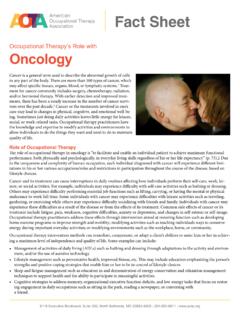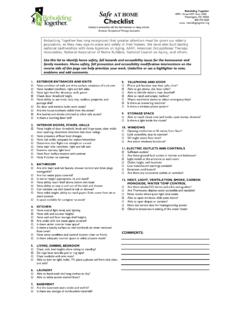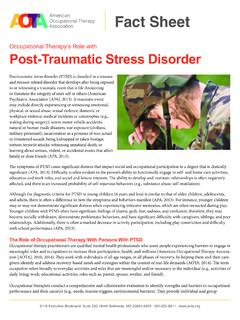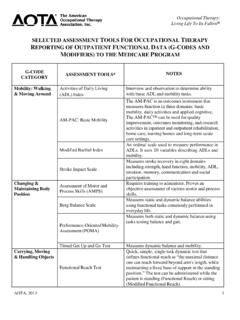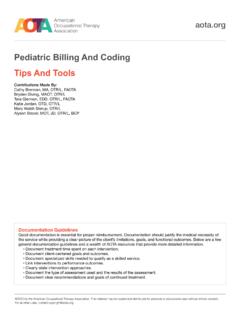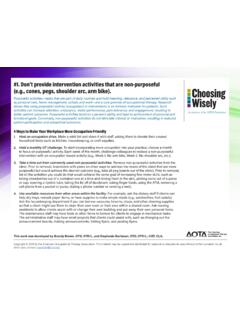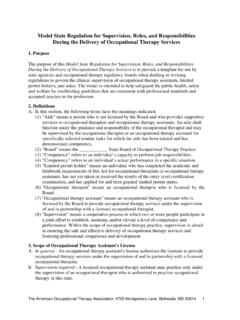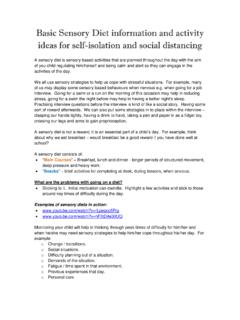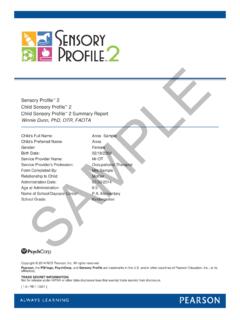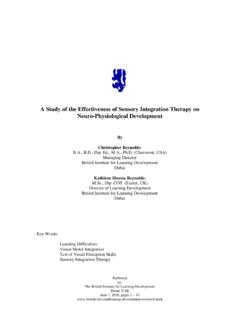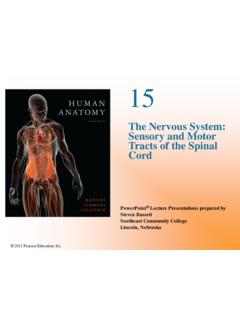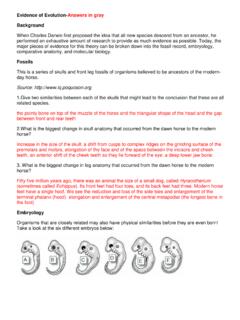Transcription of From the American Occupational Therapy Association ...
1 From the American Occupational Therapy AssociationFrequently Asked Questions About Ayres sensory Integration What is sensory integration or Ayres sensory Integration ? sensory integration is the process by which people register, modulate, and discriminate sensations received through the sensory systems to produce purposeful, adaptive behaviors in response to the environment (Ayres, 1976/2005). The sensory systems we depend on for input include vision, auditory, gustatory (taste), olfactory (smell), tactile (touch), proprioceptive (joint position sense), and vestibular (balance and movement). Effective integration of these sensations enables development of the skills needed to successfully participate in the variety of Occupational roles we value, such as care of self and others, engagement with people and objects, and participation in social contexts.
2 The therapeutic approach of sensory integration was originally developed by A. Jean Ayres, PhD, OTR, and is formally known as Ayres sensory Integration (ASI; Ayres, 1989). ASI includes the theory of sensory integration, assessment methods to meas- ure sensory integration, and a core set of essential interven-tion constructs that can be utilized to intervene with clients who have difficulty processing sensory information. How does sensory integration affect Occupational performance?As children grow, they typically develop the refined ability to appropriately register, modulate, and discriminate sensory information to support the development of effective emotion regulation, social skills, play skills, and fine motor and gross motor skills.
3 Problems effectively integrating sensation can limit a child s ability to attend to tasks, perform coordinated motor actions, plan and sequence novel tasks, develop social relationships, manage classroom demands, perform self-care tasks, and participate in family activities. When problems in processing sensory information interfere with the child s ability to perform or participate in age-appropriate activities of daily life or occupations, Occupational Therapy using an ASI approach can help to address these using an ASI approach, therapists rely on their understanding of the dynamic interactions among all the sensory systems to understand the underlying reasons why a child might be struggling with the attainment of skills to support his or her Occupational engagement.
4 How many children have problems with sensory integration?According to available research findings, it is estimated that 40% 80% of children (Baranek et al., 2002) and 3% 11% of adults (Baranek, Foster, & Berkson, 1997) with develop-mental disabilities also have significant sensory processing difficulties. In addition, sensory processing difficulties are estimated to occur in 10% 12% of individuals in the general population who have no identified diagnostic condition (Mc-Intosh, Miller, Shyu, & Hagerman, 1999).Are sensory integration deficits known to be associated with any specific diagnoses?Although a variety of children may benefit from occupa-tional Therapy using an ASI approach, the children who are most typically referred for intervention include children ages birth through adolescence who are struggling academi-cally but who do not have a clear diagnosis, as well as those children with such specific diagnoses as autism spectrum disorder, learning disability, nonverbal learning disability, developmental delay, ADHD [attention deficit hyperactivity disorder], regulatory disorder, and developmental coordina-tion does a practitioner determine whether a child could benefit from Occupational Therapy using ASI?
5 When a child is referred for an Occupational Therapy evalua-tion, the Occupational therapist will rely on a variety of strate-gies to assess the issues under-lying the expressed concerns. If sensory processing problems are suspected, the therapist may use specific ASI evaluation methods including observa-tion of the child in the natural setting, caregiver and teacher interviews, standardized testing, and structured clinical observa-tions to determine the specific ways in which disordered use of sensation is interfering with the child s functional performance. When sensory integration deficits are suspected, a prac-titioner with specialized training can administer the sensory Integration and Praxis Tests (SIPT; Ayres, 1989) to determine the specific areas of sensory integration that are problematic for the child.
6 If the evaluation results indicate that the child is having underlying problems processing sensory information, the Occupational therapist would recommend Therapy using an ASI are the sensory Integration and Praxis Tests?The SIPT is a battery of 17 standardized tests originally de-veloped by Dr. A. Jean Ayres to assess the sensory process-ing abilities of children ages 4 years, 0 months to 8 years, 11 months (Ayres, 1989). The SIPT is the gold-standard for assessing sensory integration and praxis problems (Schaaf & Smith Roley, 2006) and provides therapists with a unique perspective on the underlying causes for problems in oc-cupational performance. The SIPT is a norm-referenced test and scores obtained reliably provide insight about how the child is performing relative to same-age peers who are typi-cally does a therapist receive training in the sensory Integration and Praxis Tests?
7 Administration of the SIPT requires advanced training in sensory integration theory and certification in test admin-istration and interpretation. Certification is available to Occupational therapists, physical therapists, and speech-lan-guage pathologists through the University of Southern Cali-fornia and Western Psychological Services Comprehensive Program in sensory Integration. The certification process includes a series of four courses addressing sensory integration theory, SIPT administration, SIPT interpretation, and sensory integration intervention. Certified Occupational Therapy assistants and physical Therapy assistants are eligible to attend the courses on theory and intervention if they are sponsored by an Occupational therapist or physical therapist who has completed or is in the process of complet-ing all the courses of the certification in sensory integration and who pledges to continue supporting the assistant upon completion of the more detailed information about certification in sensory integration, please visit or advanced training in sensory integration required for me to practice as an Occupational therapist?
8 No. Throughout the United States and the international oc-cupational Therapy community, many Occupational therapists specialize in evaluating problems in sensory processing and provide ASI intervention. Although advanced training in ASI is not required, most therapists well versed in assess-ing the discrete needs of children with sensory integration difficulties have received specialized training and mentoring in the ASI theory, which may include use of the SIPT and other specific methods of evaluating sensory integration, as well as specific use of ASI intervention would I use an ASI approach?ASI intervention would be used when, after evaluating the child s Occupational performance deficits, the therapist concludes that one of the underlying causes for these perfor-mance deficits is a result of poor sensory processing.
9 Best practice to address the sensory processing deficits utilizing an ASI approach would include the essential core elements outlined in the next does an Occupational Therapy session using ASI look like?Once the evaluation is complete, the Occupational therapist will design an intervention plan aimed at enhancing the child s unique ability to utilize sensation. This often includes careful use of vestibular, proprioceptive, and tactile sensory input to help the child develop a foundation of ordered sensory processing on which functional skills can be built. When the Occupational therapist is using ASI intervention techniques, several core elements will be evident. Some of these core elements include: the ASI intervention occurs within an environment that is rich in tactile, proprioceptive, and vestibular oppor-tunities and that creates both physical and emotional safety for the child; adaptive responses by the child to the environmental context, activity challenge, and unique sensory experi-ences are evident; all therapeutic activities are child directed and therapist supported; many therapeutic activities will challenge the child to develop ideas about what to do, allow the child to plan out these ideas and then successfully carry out the plans.
10 And many therapeutic activities will promote postural con-trol and balance, which may include the use of special-ized equipment such as suspended apparatus, scooters, and balls (Parham et al., 2007).What s the difference between modulation and discrimination?The theory of ASI includes the constructs of sensory modu-lation and sensory discrimination. Both are typical processes that develop in the human nervous system and are encom-passed under the umbrella of sensory integration abilities. Modulation refers to the child s ability to grade responses to incoming sensory information and produce behaviors that are neither overreactive nor underreactive to the situation. Discrimination refers to the child s ability to accurately perceive a sensation and utilize the sensation in a refined way to produce adaptive functional behaviors.
